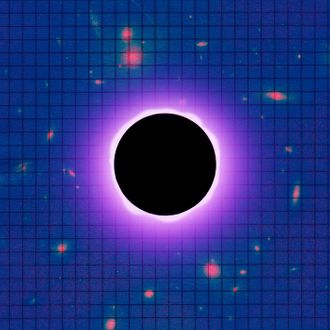
Oh, you were freaking out about Mercury retrograde? Babe, wake up: The first eclipse of the year is here. Touching down on Thursday, April 20, is a solar eclipse in Aries. Eclipses are always a big deal, but this one is extra juicy. Read on for everything you need to know about the upcoming solar eclipse.
Okay, but first, what actually is an eclipse?
Both the sun and moon follow steady, predictable paths that flow together in tandem. Although we know the sun doesn’t move from an astronomical perspective, we experience its dance across the sky from our earthbound vantage: It rises, it sets, and it occupies different areas of the cosmos based on seasonal shifts. The moon, likewise, abides by its own special orbit that resets every 28 days. The cycle opens with a new moon (a time for setting intentions and creating manifestations), moves into its waxing phases (where the moon appears to get larger), reaches its crescendo with a full moon (excellent for releases and emotional purges), and then shifts into the final waning phases (as the moon disappears into darkness). These celestial twirls are rhythmic and constant … until the eclipses come around.
Eclipses are powerful departures from the standard lunar cycle. Because the moon spins around the Earth like a dreidel, shifting back and forth on its axis, it will eventually always reach the top and bottom of its twirl. These points are referred to as the lunar nodes — the north node corresponds with the highest point of its rotation, and the south node is the lowest point.
Because the apparent size of the sun (as seen from Earth) is almost identical to the apparent size of the moon (a coincidence — or not), an extraordinary phenomenon occurs when the moon reaches the top or bottom of its spin. When this occurs during a new moon, the moon temporarily wedges itself between the sun and Earth, obstructing the sun’s light and transforming night into day during a solar eclipse. When this occurs during a full moon, Earth comes between these two luminaries, and rather than reflect the sun’s light, the moon reflects the Earth’s tawny shadow, thus creating a blood moon lunar eclipse.
Sounds dramatic? We’re only just getting started.
What happens during an eclipse?
Just as eclipses shake up the normal cycle of the sun and moon, they also rattle our realities here on earth. Because the lunar nodes are associated with destiny (specifically, the south node represents our past, while the north node symbolizes our future), eclipses catalyze big, major transformations. And don’t just take it from me — eclipses have been associated with massive sociopolitical shifts (think monarchs dying, regimes collapsing, etc.) for thousands of years. Humanity has lived through enough of these to know that eclipses don’t necessarily mean the end is nigh — but they do often signal groundbreaking metamorphosis on a macro scale.
And we should also expect these big changes to impact us on a personal level. Eclipses speed up time, perpetuate the inevitable, and expedite fated events. During an eclipse, that dull whisper of “maybe I should be doing things differently” suddenly turns into a siren’s screech, and all forces make it glaringly obvious that transformation is imminent. Simply put, if you’ve been careening down the wrong path, the upcoming eclipse will course-correct (in a not so subtle way).
What should I know about this eclipse?
This April 20 eclipse is super special because it kicks off an entirely new eclipse series across the Aries-Libra axis. (Aries and Libra are opposite signs in astrology, so when eclipses fall on the axis, it means that eclipses will occur during Aries or Libra season, respectively.) The energies surrounding these zodiac signs are really distinctive — Aries, the first sign of the zodiac, is all about “me,” whereas Libra (represented by the scales of balance) is associated with “we.” Likewise, these eclipses will address issues pertaining to autonomy and unity, independence and partnership, individuality and collaboration, freedom and alignment.
While people with planets or placements in a “cardinal sign” (a zodiac classification shared by Aries, Cancer, Libra, and Capricorn, which all occur at the beginning of seasons and considered expert initiators) may feel the vibrations of this eclipse most strongly, don’t forget that everyone has every zodiac sign in their birth charts, which means no one will come out of this unscathed. My recommendation? Use a birth-chart calculator (my recommendation is TimePassages) to see which houses are associated with Aries and Libra in your birth chart, as those will be the domains (and corresponding themes) most impacted by the forthcoming eclipse series.
How should I prepare?
The upcoming solar eclipse in Aries may be kicking off a brand-new cycle, but if you go back in time just far enough, you can actually reflect on its previous iterations. The previous Aries-Libra eclipses occurred from 2013 to 2016 (if you’re interested to know the exact dates, you can check them here). It’s very likely that whatever central narratives were present in the last Aries-Libra eclipse series will resurface once again. However, an important thing to know about eclipses is that the story goes through a 180-degree swap each cycle (during the last Aries-Libra eclipse series, the south node was in Aries and the north node was in Libra, but during the upcoming eclipse series, the south node will be in Libra and the north node in Aries). Simply put, while you may discover that some of the narratives may be similar, they’re likely to present totally different — perhaps even opposite — circumstances when they resurface.
In addition to reflecting on the past, I recommend getting a designated eclipse journal for tracking the upcoming Aries-Libra series. There will be six eclipses in this series, landing on April 20, 2023; October 14, 2023; March 25, 2024; April 8, 2024; October 2, 2024; and March 29, 2025, which means the broader story will unfold gradually over the next few years. Of course, it’s often hard to see the forest through the trees when you’re in the thick of it, so tracking your experiences (taking a simple inventory of who, what, where, when, and why will do the trick) will help you follow along with more awareness.
And there is one more thing. I do not recommend manifesting or performing any ritual magic during an eclipse. Remember, people, these are not your typical new or full moons. Because eclipses work with the lunar nodes, they’re on a different timeline than the luminaries (the sun and moon); eclipses move on an 18-year orbit referred to as the “saros cycle,” which means they’re tending to large-scale, big-picture, macro narratives that are way outside our scope of understanding. Let me put it this way: Manifesting whether your crush will text you back when the energy is about your long-term destiny just doesn’t make the most sense. Plus, the energy around eclipses is too volatile, too chaotic, and too unpredictable. So, when in doubt, remember that it’s okay to step into the passenger’s seat during eclipse season and take a more passive role. Trust that, even if you’re not quite sure how it’s all going to play out, the eclipses have a game plan that’s absolutely coming to fruition. So sit back, “relax,” and enjoy the ride!
More Astrology News
- How Astrologically Compatible Are You Really?
- Love Horoscopes to Plan Your Valentine’s Day Around
- What Does Astrology Have to Say About Inauguration Day?


